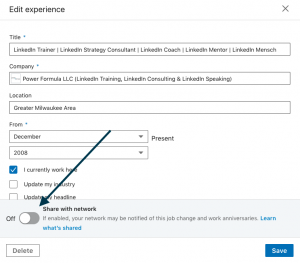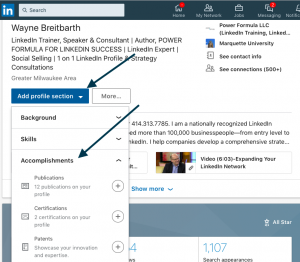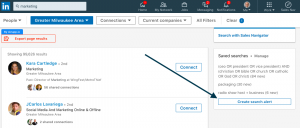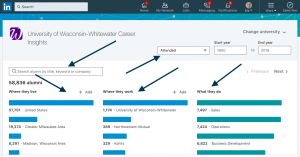Are you stuck in a dead-end job? Not making the money you deserve? Just need a change but afraid your boss will find out if you start looking for a new job? LinkedIn  to the rescue!
to the rescue!
Obviously, you don’t want to use words like seeking, pursuing or looking in your LinkedIn profile—that’s the quickest way to the unemployment line. But sprucing up your profile, joining the right groups, and “following” companies you’d like to work for are a few of the easy steps you can take when looking for a new job “under the radar.”
.
Spruce up your profile
If you have used your LinkedIn account sparingly and all of a sudden there’s a flurry of activity, this might be a red flag to your boss.  Therefore, if you plan to make edits to your profile, be sure that the Share with network button is toggled over to "No" to turn off the notifications to your network about the profile changes you are making.
Therefore, if you plan to make edits to your profile, be sure that the Share with network button is toggled over to "No" to turn off the notifications to your network about the profile changes you are making.
Keywords. Use plenty of the keywords hiring managers and recruiters might use to find people with your specialties and skills (e.g., job duties, titles, industry certifications, software expertise, etc).
For help on this, download my worksheet Keywords: The Key to Being Found on LinkedIn from the free resources page of my website.
Summary. This is tricky. You need to look like a happy employee while at the same time touting your expertise and accomplishments. Keywords are definitely important. For example, “Johnson Company always puts the customer first, and my attention to detail and ability to provide excellent customer service make me a good fit at Johnson.”
Experience. Include a detailed description of your accomplishments for every job entry you include in this section. You’re trying to differentiate yourself from other job applicants, so don’t skimp here.
Headline. You only get one shot at a first impression. Make it a good one. It’s short—only 120 characters on the desktop—so you’ll need to be creative. But if you input this section using your LinkedIn mobile app, then you get 220 characters. A note of caution: Most people can use this trick, but occasionally people find that LinkedIn won't let them do this. I hope you're one of the lucky ones! Also, be sure to include your best keywords.
For additional help on this critical section of your profile, download my free worksheet The Definitive Worksheet to Optimize Your LinkedIn Profile Headline on the free resources page of my website.
Skills. LinkedIn members will give you endorsements for your skills, and you’ll want to focus on including the skills you hope to use in your new job.
Accomplishments special profile sections. Options include Publications,  Certifications, Patents, Courses, Projects, Honors & Awards, Test Scores, Languages, and Organizations. These are a terrific way to impress readers of your profile and differentiate yourself from other candidates.
Certifications, Patents, Courses, Projects, Honors & Awards, Test Scores, Languages, and Organizations. These are a terrific way to impress readers of your profile and differentiate yourself from other candidates.
Education. In addition to your general educational background, include any specialized courses you’ve completed. Describe them in detail and use lots of keywords.
Recommendations. Outside corroboration of the information on your profile is extremely important. Your two most recent recommendations will be prominently displayed on your profile, so try to get at least two current, impactful recommendations. You probably don’t want to ask your boss for a recommendation, but customers, vendors, and college professors (for recent grads) are great options.
.
Be proactive
Once your profile is in tip-top shape, you’re ready to start actively looking for a job.
 Jobs Tab. Be sure to set your career interest preferences. Also, use the job search function here to laser focus your search for job postings that fit your desired positions. You can set up to ten job search alerts. It’s like having a 24/7 virtual assistant. LinkedIn will alert you when jobs are posted that meet your criteria.
Jobs Tab. Be sure to set your career interest preferences. Also, use the job search function here to laser focus your search for job postings that fit your desired positions. You can set up to ten job search alerts. It’s like having a 24/7 virtual assistant. LinkedIn will alert you when jobs are posted that meet your criteria.
 Create search alerts. With a free LinkedIn account, you can create up to three Advanced People Search alerts. Use these for your target companies—the places you’d most like to work.
Create search alerts. With a free LinkedIn account, you can create up to three Advanced People Search alerts. Use these for your target companies—the places you’d most like to work.
Groups. Join industry groups, and check each group’s Jobs tab for job postings. If you join job-hunting groups, don’t post discussions or show the group logo on your profile. Do participate in industry groups and demonstrate your thought leadership.
 Alumni. Access this by clicking the name of one of the schools you attended on your profile. Then click the blue See alumni button from that university's LinkedIn page. Use the available filters to find out if any fellow alumni work at the companies where you're interested in exploring a new opportunity. This is a great way to get the inside scoop on jobs posted and not yet posted.
Alumni. Access this by clicking the name of one of the schools you attended on your profile. Then click the blue See alumni button from that university's LinkedIn page. Use the available filters to find out if any fellow alumni work at the companies where you're interested in exploring a new opportunity. This is a great way to get the inside scoop on jobs posted and not yet posted.
“Follow” companies. Go to the company page of your target companies and “follow” them. You'll then be notified of job postings and employment changes at the company.
If you follow this advice, HR professionals and recruiters will start discovering your profile. But don’t just sit around and wait for a job offer. Be an active part of the almost 600 million member LinkedIn community, and before you know it you’ll have landed the job of your dreams.



Hey! This post is really helpful for newbies like me. I’m a fresher in this industry & I want to start a company of my own, This is my dream. Your post helped me a lot with a lot of important info. very appreciating man! keep sharing.